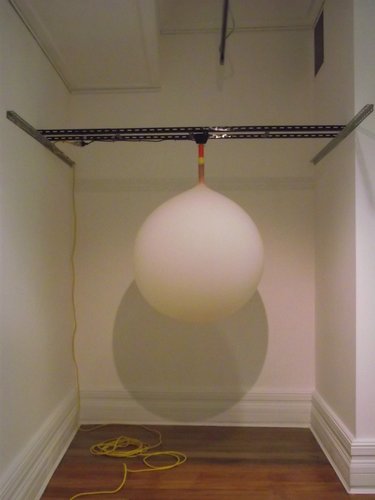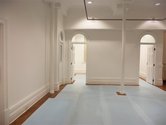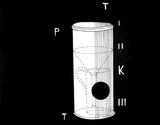John Hurrell – 6 September, 2011
The twenty-three drawings, in a range of sizes, seem to represent micro climates and the sculptures, macro versions. Within his black inked compositions of floating telescopes, measuring rulers, volumetric receptacles, leaning ladders, extended platforms, glowing bulbs and storage shelving one finds that the circular black holes might also be small weather balloons, acquiring data for a race of midget Lilliputians.
As an exhibition of Paul Cullen’s ink and acrylic drawings and kinetic sculptures, this show references matters meteorological and the science/climate education company How The Weather Works.
The presentation is typical Cullen in that a gentle humour pervades, subverting assumed certainties of science, blocking off in his drawings of hovering tools or inserted and encasing receptacles, possible vectoring continuums through overlayed and circular ‘black holes’. Sometimes as in one sculpture, he causes the straining motor to generate lurching irregular rhythms by adding plasticine counterweights to its turning globe, or just as funny, sticking red blobs (like mountain ranges) on a large flat map of the world, a ‘flat earth’ positioned on its side - with a rectangular portion cut out to undermine any possible practical benefit.
One other sculpture is a large bobbing weather balloon held to the walls by metal struts, and very slowly turning like a soft egglike eyeball; seeming alive and ominous (think McGoohan’s ‘The Prisoner’) - though a symbol in Cullen’s hands for a self-contained eco system. A fourth sculpture is (in Carl Andre’s floor ‘carpet’ sense) also a painting on the floor, a large sea of pale sky blue we walk over to get to Cullen’s drawings in a side room, a colour spatially inverted in relation to the habits of our moving bodies.
The twenty-three drawings, in a range of sizes, seem to represent micro climates and the sculptures, macro versions. Within his black inked compositions of floating telescopes, measuring rulers, volumetric receptacles, leaning ladders, extended platforms, glowing bulbs and storage shelving one finds that the circular black holes might also be small weather balloons, acquiring data for a race of midget Lilliputians.
With these two types of measuring (and potentially measured) worlds it is a smart guess to speculate whether it might have something to do with quantum physicist Werner Heisenberg’s famous Uncertainty Principle.
For the online magazine Slate, philosophy journalist Jim Holt expresses that principle this way, that…some pairs of properties are linked in such a way that they cannot both be measured precisely at the same time. In physics, these pairs are called “canonically conjugate variables.” One such pair is position and momentum: The more precisely you locate the position of a particle, the less you know about its momentum (and vice versa). Another is time and energy: The more precisely you know the time span in which something occurred, the less you know about the energy involved (and vice versa).
We can speculate that with these pairs, one part resides within the 3D conceptual models of the sculptures that can be imagined (in smaller versions) inserted within the other much tinier conceptual schemata of the drawings - while according to Heisenberg certain desirably comparable qualities cannot be calculated simultaneously. Any measuring together collapses.
The charm of this exhibition is that Cullen invites these imaginative leaps connecting sculpture, drawing and the natural laws of the world and its weather. Though the sculptures, their surfaces, mechanical processes and possible symbolism are important, how they can be ‘actors’ on the ‘stage’ of the drawings really intrigues. That synthesis makes them unusual - and stimulating for eco-reflection.
John Hurrell












 Two Rooms presents a program of residencies and projects
Two Rooms presents a program of residencies and projects Advertising in this column
Advertising in this column



This Discussion has 0 comments.
Comment
Participate
Register to Participate.
Sign in
Sign in to an existing account.